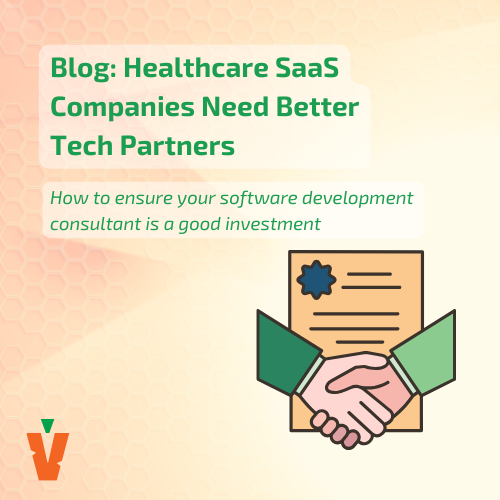As an executive of a health tech company, we understand that you're no stranger to the complex maze of healthcare software development. Undoubtedly, the technical brilliance underpins your organization. But without effectively translating that brilliance into board-friendly language, it's like owning a Ferrari without a driver's manual – beautiful but not reaching its full potential.
Having everyone on the team speak the same language is essential for streamlined decision-making. The engineering world and business stakeholders have different priorities and vocabularies. While engineers geek out over algorithms and software features, boards crave ROI and market share. So, how do we untangle the knot in priorities and views?
The Communication Knot
Engineers are a unique breed, and we mean that most endearingly; after all, they make most of our company. They are the architects and builders of the digital healthcare landscape. However, they often come from a world where the language of ones and zeros reigns supreme. Their priorities center on crafting elegant code, optimizing algorithms, and ensuring robust cybersecurity. While these aspects are crucial to the success of your health tech company, they might seem like arcane runes to the uninitiated.
The boardroom, on the other hand, speaks a different language. Key performance indicators (KPIs), market share, and return on investment (ROI) are almost all they care about. They're concerned about scalability, profitability, and market competition. These differences can lead to two parallel universes within your organization, especially when its success lies in healthcare software development.
You might be thinking, "Why can't the engineers just speak in simpler terms?" It's a valid question, but the answer is more complex. Engineers are not intentionally obfuscating their communication; they're passionate about their work and deeply immersed in the technical details.
Miscommunication isn't just a minor hiccup; it can derail projects and hinder organizational goals. Decisions made without a clear understanding of the technical intricacies can lead to suboptimal choices, project delays, and missed opportunities in the fiercely competitive health tech landscape.
In the next section, we'll delve into strategies for bridging this communication gap, helping your CTOs convey their technical expertise in ways that resonate with the board's priorities and goals.
Bridging the Language Gap
Are your technical goals aligned with overarching business objectives? Most of our clients in healthcare software development felt there was at least room for improvement before working with us, and some of them knew from the get-go the answer was no. Here’s why aligning every technical decision with your company’s strategic vision is imperative - and how to do it.
- Purposeful progress: When technical goals are closely tied to business objectives, every step in your project serves a clear purpose. This means that resources, time, and effort are directed toward achieving outcomes contributing to your company's growth and success.
- Efficient resource allocation: Aligning objectives allows for an efficient allocation of resources. It ensures you're not investing in technical endeavors that don't advance your business goals. Instead, you're prioritizing initiatives that directly impact your bottom line.
- Board confidence: When the board sees that technical goals are in sync with the bigger picture, they are more likely to have confidence in the decisions made by their CTO and technical teams. This confidence can lead to quicker approvals and smoother project execution.
These tips are commonsense, but they're easy to forget as a healthcare Project Manager. That's why it's essential that you keep learning - check our list of resources for PMs to find more.
5 Tips For Setting Clear Objectives
Now, let's explore some practical tips for setting clear, measurable, and board-friendly objectives for your health tech projects:
- Specificity: Objectives should be specific and well-defined. Avoid vague statements like "improve system performance." Instead, specify what you mean by improvement – perhaps by reducing response times by 20%.
- Measurability: Make sure your objectives are measurable. You should be able to track progress and determine whether you've met the goal. Use quantifiable metrics such as revenue increase, user engagement, or system uptime.
- Alignment: Ensure each objective aligns with your company's strategic goals. Ask yourself how achieving this objective contributes to your broader mission and vision.
- Regular Project Health Checks: Objectives should be realistic and attainable. Setting attainable goals can lead to satisfaction and demotivation among your technical teams. Balance ambition with feasibility. We do regular Sanity Checks for our clients to ensure we spend their money wisely. Click here to learn more about the Sanity Check process at Vitamin Software and how we implement it before the engagement and throughout the client journey.
- Time-Bound: Assign a timeframe for achieving each objective. This adds a sense of urgency and helps in project planning. For example, you might set a goal to reduce data processing time by 15% within six months.
Demonstrating the Bottom Line Impact
The board is primarily concerned with how technical decisions impact the company's bottom line. Demonstrating this correlation is critical for boardroom success. Here's how to do it:
- Financial metrics: Translate technical achievements into financial metrics whenever possible. For example, quantify the annual savings if a software optimization reduces server costs by 30%.
- Risk mitigation: Explain how technical decisions mitigate risks affecting profitability. For instance, improved cybersecurity measures can prevent data breaches that could result in costly lawsuits and reputation damage.
- Market positioning: Showcase how technical advancements contribute to your company's competitive edge. If a new feature attracts more users or retains existing ones, emphasize its impact on market share.
- ROI projections: Provide projections on the return on investment (ROI) for technical initiatives. Outline the expected benefits and costs and discuss the payback period.
Copy Our Process for Reliable Executive Reporting
We specialize in turning complex technical project statuses into concise, actionable executive reports. Our team is well-versed in translating intricate details into boardroom-friendly language. We've helped numerous health tech companies bridge the communication gap between their CTOs and boards. Let's explore how we do it.
1. Comprehensive Data Aggregation
We gather a wealth of data from your technical teams, project managers, and stakeholders. We leave no stone unturned, collecting everything from project timelines and budget updates to technical challenges and resource allocations.
2. Streamlining Information
The key to our success lies in distilling this information into its most essential components. We identify the critical data points that directly impact business objectives and project outcomes. This includes highlighting achievements, challenges, and deviations from the original plan.
3. Visual Storytelling
We understand that executives often absorb information more effectively through visuals. Therefore, we employ data visualization techniques to create compelling charts, graphs, and diagrams that present complex data in a digestible format. These visuals convey the big picture at a glance.
4. Executive Summaries
Our reports always include executive summaries that capture the essence of the project status. These summaries are crafted to be concise yet comprehensive, providing an overview of key milestones, risks, and opportunities. We ensure that they align with your business goals and priorities.
5. Clear Objectives Alignment
One of our strengths is aligning technical progress with overarching business objectives. We help your board understand how each technical decision impacts the bottom line. By highlighting the strategic implications of technical choices, we ensure that the board can make informed decisions.
Executive Reports: Aligning Engineering and Business Goals
Are misalignments in your engineering and business efforts making you face budget constraints and a dire need for a seamless product release in healthcare software development? Our expertise can streamline your project budgeting and align your engineering and business goals. Contact our team today and embark on a journey towards an efficient and patient-centric healthcare solution backed by powerful executive reports.
If you’d like to learn more about how we’ve leveraged Executive Reports to bridge the gap between engineering and business language, check out how our expertise in healthcare software development saved a SaaS healthcare client over $500,000 while ensuring a seamless product launch and fostering alignment between engineering and business goals.




